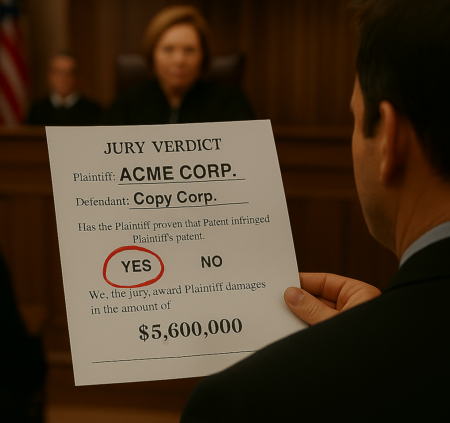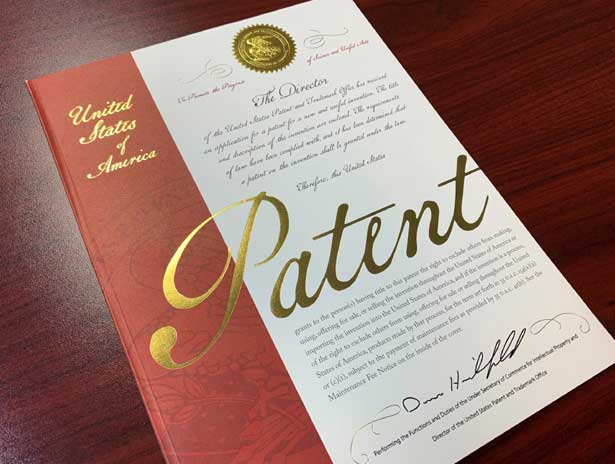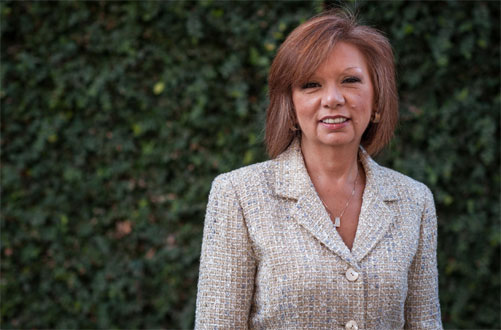
U.S. patent law provides for both injunctive relief, which halts infringing activity, and monetary compensation for the harm suffered by the patent holder. The monetary compensation may be measured in the patent holder's lost profits or a reasonable royalty that the infringing party would have paid. Also, in some cases, a jury may award enhanced damages in exceptional cases where the defendant acted egregiously.
Patent infringement is a potential issue for any business developing new products and services. It is important to understand the risk of patent infringement and the monetary damages that might result from infringement. The types of patent damages are explored in more detail below.
When a defendant is found liable for patent infringement, U.S. law ensures that the patent owner receives fair compensation. Under 35 U.S.C. § 284 of the Patent Act, once a court determines that a defendant's infringement has occurred, it must award the patentee "damages adequate to compensate for the infringement, but in no event less than a reasonable royalty" for the unauthorized use of the patented invention. These damages are designed not to punish the infringer, but to restore the patent holder to the financial position they would have been in had the infringement not occurred. However, if the infringement is proven to be willful, the court may award enhanced damages, up to three times the compensatory amount.
The law recognizes two main forms of compensatory damages:
Lost profits are one of the most significant categories of patent infringement damages because they aim to place the patent owner in the financial position they would have occupied “but for” the infringement. In other words, these damages are meant to compensate for the sales, market share, and profits the patentee lost due to the infringer unlawfully making, using, or selling the patented product.
To succeed in a claim for lost profits, the patentee must present evidence at trial that satisfies a four-part test established in Panduit Corp. v. Stahlin Bros. Fibre Works, 575 F.2d 1152 (6th Cir. 1978). The elements are:
In addition to diverted sales, courts may consider other economic harms, such as price erosion (where the infringer’s competition forces the patentee to lower prices), increased costs (from fighting to maintain market share), and convoyed sales, losses on related products or services sold in conjunction with the patented item (e.g., parts, accessories, or maintenance services).
Proving lost profits often requires detailed financial records and expert testimony, and it can be particularly challenging when the patent owner is not actively selling the product. In such cases, courts typically award reasonable royalty damages instead.
When a patent owner cannot prove lost profits, they are still entitled to damages under the Patent Act, specifically, a reasonable royalty. Under 35 U.S.C. § 284, “[u]pon finding for the claimant the court shall award the claimant damages adequate to compensate for the infringement, but in no event less than a reasonable royalty for the use made of the invention by the infringer”. This provision guarantees a minimum baseline of compensation and ensures that patentees receive some remuneration even when actual losses are difficult or impossible to quantify.
A reasonable royalty is calculated based on a hypothetical negotiation between a willing licensor and a willing licensee at the time the infringement began. This legal fiction allows courts to simulate what the parties would have agreed upon in a good faith license negotiation, had infringement not occurred. The foundational authority for evaluating reasonable royalties comes from Georgia-Pacific Corp. v. U.S. Plywood Corp., 318 F. Supp. 1116 (S.D.N.Y. 1970), which identified 15 non-exclusive factors relevant to determining the royalty rate. These include:
One key legal requirement is apportionment, the process of ensuring that damages reflect only the value of the patented feature, and not the value of the entire product unless the patented feature drives consumer demand. The Federal Circuit has emphasized that “a patentee is only entitled to a reasonable royalty attributable to the infringing features”. Power Integrations, Inc. v. Fairchild Semiconductor Int’l, Inc., 904 F.3d 965, 977 (Fed. Cir. 2018). This rule is particularly important in the context of complex, multi-component products, such as smartphones or software systems.
Courts often require use of the smallest salable patent-practicing unit as the royalty base to avoid overcompensation, unless the entire market value rule (EMVR) applies, i.e., when the patented component drives the demand for the entire product. LaserDynamics, Inc. v. Quanta Comput., Inc., 694 F.3d 51, 67 (Fed. Cir. 2012).

To support a damages award, expert testimony is typically required and must be grounded in economic rigor and factual evidence. Courts have excluded speculative or unsupported opinions, emphasizing the need for reliable methodologies and factual ties between the royalty and the extent of infringement. Lucent Techs., Inc. v. Gateway, Inc., 580 F.3d 1301, 1336–37 (Fed. Cir. 2009).
Thus, the reasonable royalty framework acts as both a statutory safeguard for patentees and a critical analytical tool for courts in patent infringement cases.
In addition to compensatory damages, courts may award enhanced damages, up to three times the amount of actual damages, under 35 U.S.C. § 284 when willful infringement is proven. However, enhanced damages are not available in every infringement case. The Supreme Court in Halo Electronics, Inc. v. Pulse Electronics, Inc., 579 U.S. 93 (2016), clarified that such damages are reserved for "egregious cases of misconduct beyond typical infringement", and courts have broad discretion to determine whether enhancement is appropriate.
The Halo Court rejected the prior Seagate test, which had required clear and convincing evidence of objective recklessness, finding that it was overly rigid and inconsistent with the discretionary language of § 284. Instead, Halo emphasized that willfulness should be assessed based on the infringer’s subjective bad faith at the time of the conduct, and that culpability is generally measured against the knowledge of the actor at the time of the challenged conduct.
Key factors that courts consider when determining whether to enhance damages include:
See Read Corp. v. Portec, Inc., 970 F.2d 816 (Fed. Cir. 1992).
Because the inquiry is fact-intensive and centers on intent, companies should document good-faith efforts to avoid infringement, such as conducting freedom-to-operate analyses, obtaining legal opinions, and designing around patents. These proactive steps may help a court find that the infringement was not willful, thereby avoiding exposure to treble damages.
Patent litigation can be costly, unpredictable, and disruptive. Whether you’re a patent owner seeking damages or a defendant facing exposure and seeking to limit damages, understanding how courts assess infringement damages is critical. For business owners, here are some practical takeaways:
If you need assistance with a patent dispute or other patent matter, contact our office for a free consultation.
© 2025 Sierra IP Law, PC. The information provided herein does not constitute legal advice, but merely conveys general information that may be beneficial to the public, and should not be viewed as a substitute for legal consultation in a particular case.

"Mark and William are stellar in the capabilities, work ethic, character, knowledge, responsiveness, and quality of work. Hubby and I are incredibly grateful for them as they've done a phenomenal job working tirelessly over a time span of at least five years on a series of patents for hubby. Grateful that Fresno has such amazing patent attorneys! They're second to none and they never disappoint. Thank you, Mark, William, and your entire team!!"
Linda Guzman

Sierra IP Law, PC - Patents, Trademarks & Copyrights
FRESNO
7030 N. Fruit Ave.
Suite 110
Fresno, CA 93711
(559) 436-3800 | phone
BAKERSFIELD
1925 G. Street
Bakersfield, CA 93301
(661) 200-7724 | phone
SAN LUIS OBISPO
956 Walnut Street, 2nd Floor
San Luis Obispo, CA 93401
(805) 275-0943 | phone
SACRAMENTO
180 Promenade Circle, Suite 300
Sacramento, CA 95834
(916) 209-8525 | phone
MODESTO
1300 10th St., Suite F.
Modesto, CA 95345
(209) 286-0069 | phone
SANTA BARBARA
414 Olive Street
Santa Barbara, CA 93101
(805) 275-0943 | phone
SAN MATEO
1650 Borel Place, Suite 216
San Mateo, CA, CA 94402
(650) 398-1644. | phone
STOCKTON
110 N. San Joaquin St., 2nd Floor
Stockton, CA 95202
(209) 286-0069 | phone
PORTLAND
425 NW 10th Ave., Suite 200
Portland, OR 97209
(503) 343-9983 | phone
TACOMA
1201 Pacific Avenue, Suite 600
Tacoma, WA 98402
(253) 345-1545 | phone
KENNEWICK
1030 N Center Pkwy Suite N196
Kennewick, WA 99336
(509) 255-3442 | phone
2023 Sierra IP Law, PC - Patents, Trademarks & Copyrights - All Rights Reserved - Sitemap Privacy Lawyer Fresno, CA - Trademark Lawyer Modesto CA - Patent Lawyer Bakersfield, CA - Trademark Lawyer Bakersfield, CA - Patent Lawyer San Luis Obispo, CA - Trademark Lawyer San Luis Obispo, CA - Trademark Infringement Lawyer Tacoma WA - Internet Lawyer Bakersfield, CA - Trademark Lawyer Sacramento, CA - Patent Lawyer Sacramento, CA - Trademark Infringement Lawyer Sacrament CA - Patent Lawyer Tacoma WA - Intellectual Property Lawyer Tacoma WA - Trademark lawyer Tacoma WA - Portland Patent Attorney - Santa Barbara Patent Attorney - Santa Barbara Trademark Attorney